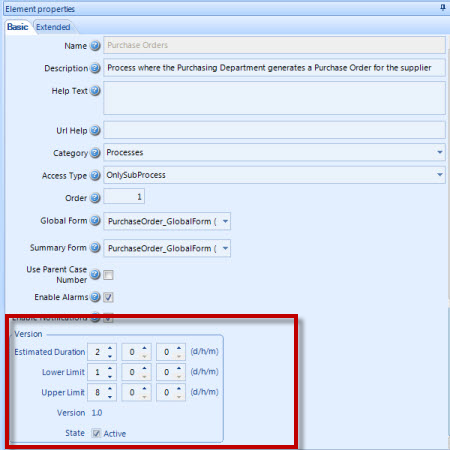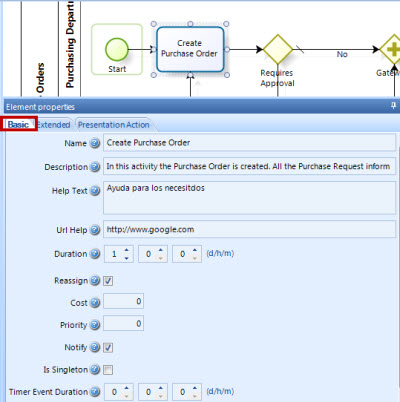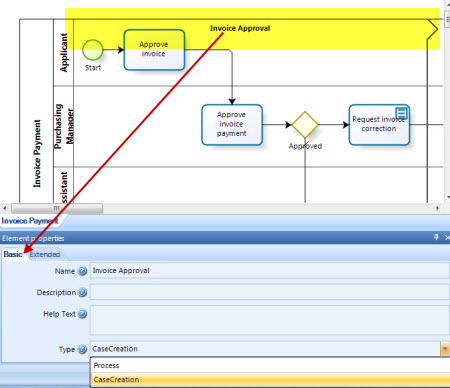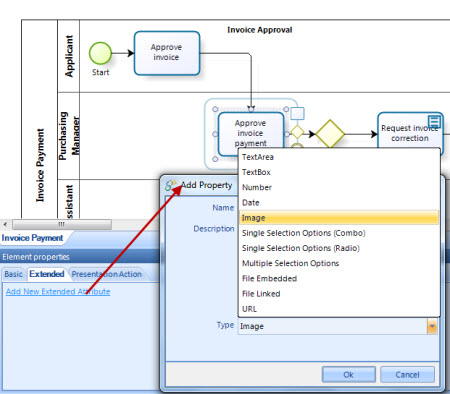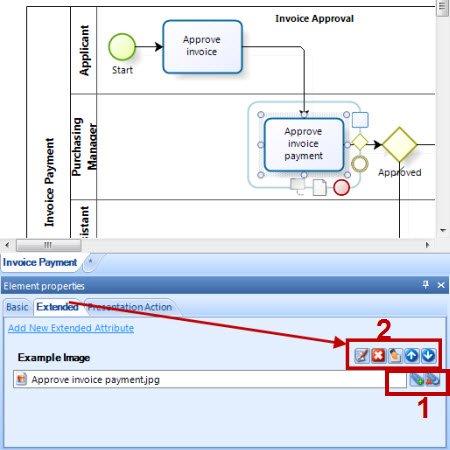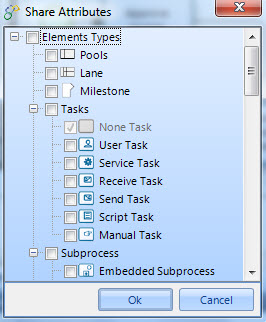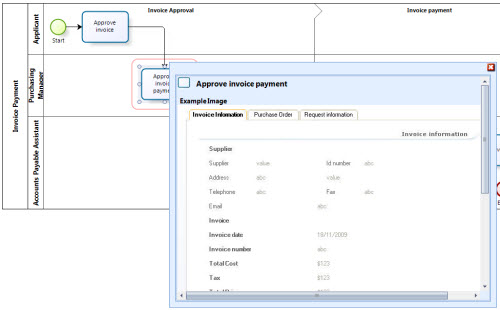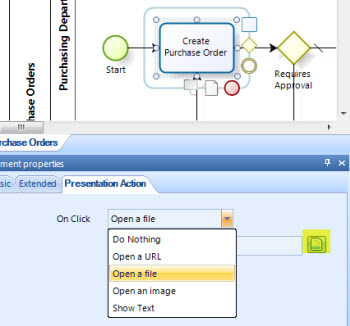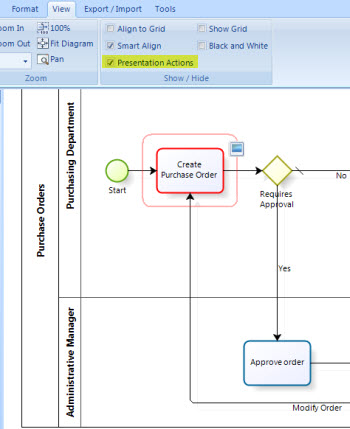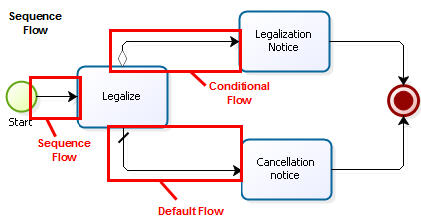Shapes Properties
From Business Process Management, BPM and Workflow Automation Wiki | BizAgi BPMS
<keywords content="keywords"> stencil properties, shape property </keywords>
Shape Properties in the workflow
Bizagi Process Modeler allows users to diagram, document and share their business processes in a standardized way. The Modeler uses the BPMN (Business Process Management Notation), a worldwide standard that enables the design of simple and complex processes for multidisciplinary teams.
In the Modeler, the Process and every shape contained in the diagram have specific properties divided into three tabs: Basic, Extended and Presentation Actions. The fields displayed in every tab vary between shape types. Right click on the Process Name or on any shape and select Properties to access them.
Presentation Actions will be displayed when the process is Exported or viewed in Presentation Mode. In order to modify the properties of a shape or the Process:
1. In the Bizagi Process Modeler, select a shape from the diagram and right click on it. Then click on the Properties option. 2. A window with the shape’s properties will be displayed on the bottom of the diagram.
Basic
The Basic Properties tab contains basic information of the process and of each shape in the diagram. The following properties apply for all shapes.
Name
This is the display name of the activity that is shown in the web application.
Description
In this field additional information for the task can be entered if needed.
Process
Help text
This text is not displayed in the web application.
Url Help
Url displayed in the Presentation Mode to access the process help defined in the company’s network.
Category
Category that the process, subprocess or module belongs to.
Access Type
There are three options: process, module and sub process. For further information go to Access Type
Order
Determines the sequence in which the processes will be displayed on the registration menu.
Global Form
Associated form that is viewed when consulting a case that has been closed or when the user has no pending activities. For more information Global Form
Summary Form
Associated forms that allows the user to view the progress information when clicking the Stoplight of the pending cases. The form is viewed in the lower part of the web application. For more information Summary Forms
Use Parent Case Number
This option will enable the display of a single case number in the Web application for the parent process as well as the sub-process that has been indicated. If this box is not checked, the sub-process will display a number other than that of the parent process corresponding to the consecutive in Bizagi.
Enable Alarms
When Alarms are configured for the process this property enables or disables the emails to be sent
Enable Notifications
When Email messages are configured for the process this option enables or disables the emails to be sent.
Estimated duration
The Duration set for Processes is the SLA (Service Level Agreement), that can be explained as the maximum time that a Process can be active (unfinished) to consider that they are still on time. The Duration is set in the development stage, and can be adjusted in production as needed in the Work Portal. This time is defined by days, hours and minutes.
Lower Limit
The minimum estimated duration time of the process. It is defined in days, hours and minutes.
Upper Limit
The estimated maximum duration time of the process. It is defined in days, hours and minutes.
Version
The version of the flowchart is specified here.
Status
It is the status of the process (active/inactive). If it is checked, the process will be available to be used (if it is a process, subprocess or module) and create cases (if it is a process). If inactive it will not be available to be used.
Tasks
Help Text
This help text is for User tasks, Manual tasks, Intermediate Events and Singletons. Bizagi’s assistant will display the help text when it has been configured in every activity.
URL Help
In this option, the user can configure a URL that contains help text for the activity.
Duration
The Duration set for Activities is the SLA (Service Level Agreement), which can be explained as the maximum time that a Task can be active (unfinished) to consider that it is still on time. The Duration is set in the development stage, and can be adjusted in production as needed.
This property applies for shapes such as Manual and User tasks, Timer Intermediate Event, Sub-process or Embedded Sub-process, Multiple Sub-process and Timer Events.
Duration is used to determine the task's state, on the pending task inbox: On time, at risk (due today), and expired (overdue). It is also used to calculate Sensors, BAM and Analytics indicators. This duration is fixed and can be adjusted in the Work Portal when the process is in production. However, the duration can be variable and defined through an Expression associated in the entrance of the figure.
Example variable duration
Reassign
When a Task or Event can be reassigned by the user during the process, this option must be checked. By default, the property is “No” (false). If it is enabled (true), the Task or Intermediate Event can be reassigned. If it is enabled a “Reassign” button will appear in the application between the “Next” and “Save” buttons.
Cost
Indicates the cost of the Tasks, Timer intermediate Event, Subprocess, Multiple Subprocess, Embedded Subprocess and Intermediate Events.
Priority
Indicates the order on which Bizagi will activate or execute Tasks, Subprocesses, or Events.
Notify
When enabled, this property notifies about the assignation to all users that have been assigned to a Task or Intermediate Event. By default, this property is set to false, so if a notification is required, check the property.
Is Singleton
This property converts a User Task to Singleton. This means that if more than one Sequece Flow reaches the Task, it will not be duplicated if there is already an active instance.
Timer Event Duration
The Timer Event Duration property is used when a Timer Intermediate Event is attached to the Task. Example
Events
Intermediate events have the same Basic Properties as the Tasks except for Duration, Is Singleton and Timer Event Duration.
Timer Events have Name, Cost and Duration. Remember this duration is fixed; however, the duration can be variable and defined through a business rule associated to an event in the entrance of the figure.
Phases
Help Text
Given an idea to the person diagramming the process of what the phase contains
Type
There are two types of Phases: CaseCreation and Process.
Extended
Extended Attributes are used for the process documentation. When any shape has these attributes included, they will be shown in the Presentation Mode to allow the presenter to complement the diagram. Extended attributes can be Texts, numbers, dates, images, Combos, radio buttons, Files, Links and URLs. According to the attribute selected, Bizagi will display a special window to configure it.
Every Extended Attribute created for one shape will be shared with all other shapes that belong to the same type of shape and are contained in the same diagram. What is shared is the Attribute but not its content.
For example, an Image will be created for all Tasks in the Invoice Payment Process. The extended attribute must be created only once. Enter the Name, Description and Type of attribute.
1. Using the PLUS and CROSS buttons, add or delete an image to the selected Task, for the Extended Attribute.
2. If necessary, use the buttons to delete, edit, share and reorganize the Attributes created.
If the attribute must be shared, select which shapes will be able to configure it.
This is how the image that was saved for the Task will look like in the Presentation Mode, when the task is clicked.
Presentation Actions
For every shape in the diagram a Presentation Action can be defined. This action will be displayed when the diagram is locked or when the Presentation Mode is enabled. The user can define for each shape one of the following actions:
- Do nothing
- URL
- File
- Image
- Text
As soon as one of them is selected, the fields to select, upload or type-in will be enabled.
When shapes have a Presentation Action created and they want to be shown, the option Presentation Actions must be enabled in the View menu. The shapes that have Actions will be displayed in Red and a small icon will be shown in the upper right corner of each one.
Conditions for Sequence Flow: Conditional Flows and Default Flows
A Sequence Flow defines the execution order of activities in any modeled process. Bizagi allows the user to incorporate conditions to them in order to decide whether or not the flow is used. A Sequence Flow with a condition is called Conditional Flow. A Default Flow is the default branch to be chosen if all other conditions evaluate to false. This conditions can be placed in any shape in the process that has more than one sequence flow, by right-clicking over it, and selecting the desired condition.
<comments />
